Welcome to our agricultural blog, where we delve into the critical topic of Pest Management in Sorghum. We’ll explore the major insect pests that pose a significant threat to sorghum crops, along with effective control and prevention methods. Sorghum, a vital crop in India and globally, faces challenges from various pests that can impact yields. Understanding these pests and implementing sound pest management practices is essential for ensuring a bountiful sorghum harvest.
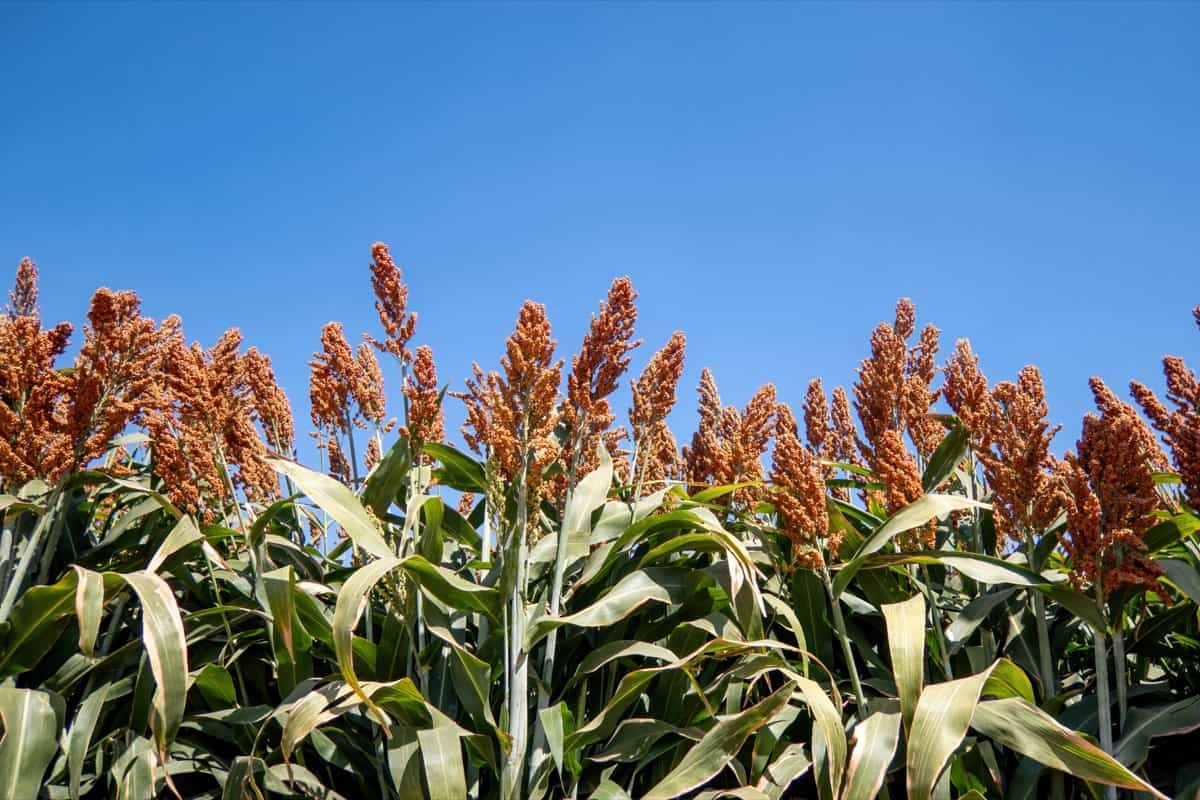
What is Pest Management in Sorghum?
Pest Management in Sorghum refers to the systematic approach taken to mitigate the impact of insect pests on sorghum crops. Sorghum, a crucial cereal crop known for its resilience in diverse environmental conditions, is susceptible to several insect pests that can significantly reduce yields. Effective pest management involves a combination of preventive and control measures, such as using resistant sorghum varieties, implementing integrated pest management (IPM) strategies, and employing eco-friendly methods like biopesticides.
India holds the 3rd position globally in sorghum cultivation area and ranks 5th in production, with the Government of India estimating a production of 4.63 million metric tons in 2019-20. However, a significant challenge arises as nearly 32 percent of sorghum yield is lost to insect pest infestation.
Panicle-feeding insects are particularly destructive among these pests, causing yield losses ranging from 4 to 84 percent. The crux of the issue lies in the presence of 5-6 major insect pests responsible for the bulk of this loss. Addressing challenges and understanding their bioecology and damage mechanisms, emphasizing the urgency of effective pest management strategies for sorghum crops.
Sorghum Shoot Fly Pest Management
Biology
- Egg Stage: Shoot fly eggs are white, shaped like cigarettes, and are typically laid singly on the underside of leaves, often parallel to the midrib of the 3rd to 5th leaf. In high shoot-fly pressure conditions, multiple eggs may be found on the same leaf, with up to 25 on a single seedling. These eggs hatch in a relatively short span of 2-5 days.
- Maggot Stage: The yellow maggot migrates to the leaf’s upper surface and enters the space between the leaf sheath and axis. Here, it cleanly cuts the leaf at its base. This larval stage lasts for approximately 6 to 10 days.
- Pupa Stage: Pupation occurs inside the stem, and adults emerge after about a week.
- Adult Stage: The adults resemble dark brown houseflies but are smaller, with males even smaller than females. Their adult lifespan typically ranges from 10 to 20 days.
Favorable Conditions
- Late-sown sorghum crops suffer more shoot fly damage due to elevated humidity and moderate temperatures.
- Infestations are usually higher in post-rainy season crops sown in September-October, with temperatures above 35°C and below 18°C reducing shoot fly survival.
Damage Symptoms
- Damage at the seedling stage (5 to 30 days after emergence) results in the characteristic “dead heart” symptom, where the central leaf dries up and can be easily pulled out, emitting a rotting smell.
- Older plants (>30 days) are typically not susceptible to A. soccata, except under high humidity conditions during the rainy season, leading to thin and papery damaged leaves.
- Late infestations can harm the panicle during the formative stage, causing rotting or drying of affected portions.
- Infested plants often produce side tillers.
In case you missed it: Weed Management in Sorghum Farming: Control with Chemical, Biological, Mulching, Herbicides, and Crop Rotation
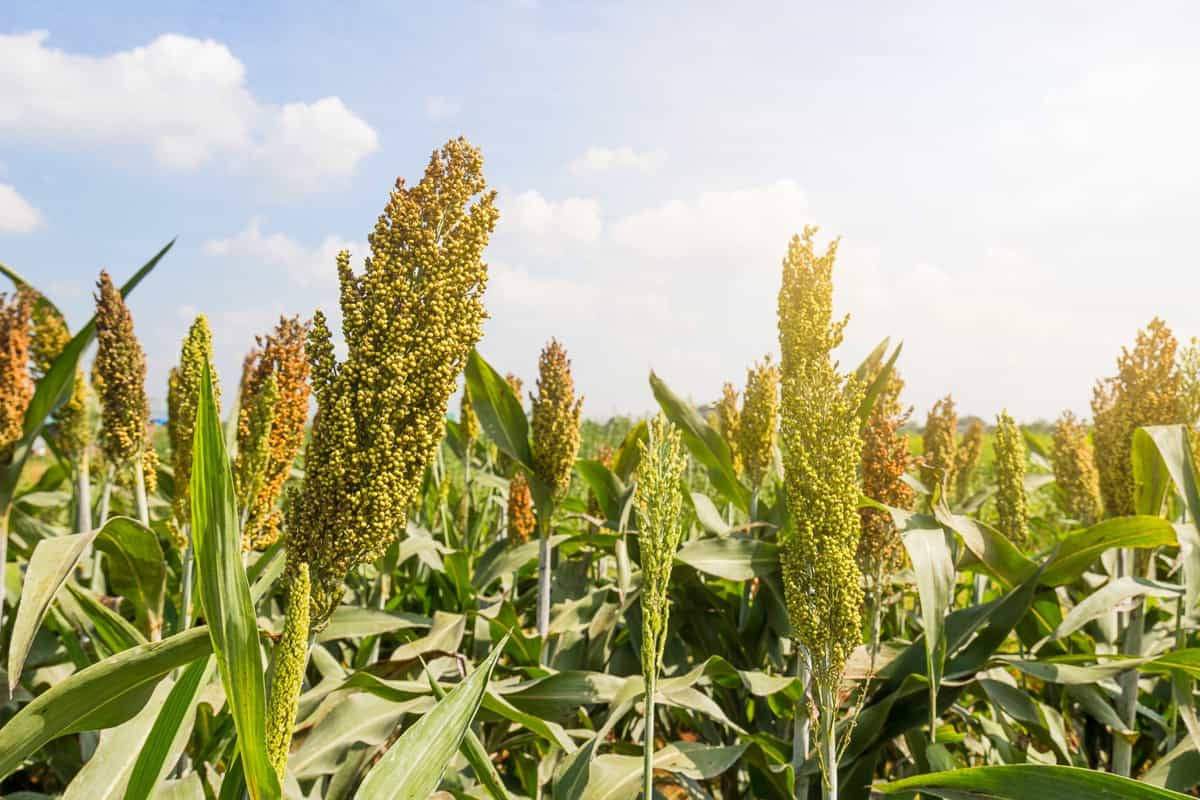
Natural Enemies
- Shoot fly has its share of natural enemies, including parasitoids such as Trichogrammatoidea simmonalsi and predators like spiders, Coccinellids, and lacewings.
Management
- Early sowing.
- Utilizing resistant sorghum varieties like CO 1, CSH-7, CSH-8, Maldandi, and Hagari.
- Employing a higher seed rate (12 kg/ha).
- Using fish meal traps.
- Removing infested plants 3-4 weeks after germination.
- Applying granular Carbofuron 3G at sowing (2.5 kg a.i./ha).
- Employing foliar sprays of cypermethrin and cartap hydrochloride was found to be effective.
Sorghum Stem Borer Pest Characteristics and Management
Biology
Eggs are laid in groups of 10-100 on the underside of leaves, and hatching occurs after 7-10 days. Young caterpillars create leaf windows and bore into the stem, with a creamy pink appearance and dark spots. The larval period lasts 28-35 days. Pupation occurs within a small chamber in the stem, with a 7-10 day period. Adult moths with wingspan of 20-30 mm, males being smaller and darker and females having paler forewings and white hind wings.
Symptoms of Damage
- Stem borers typically infest sorghum crops around a month after sowing, causing “dead hearts.” Evidence of their presence includes boreholes near the stem nodes.
- In their younger stages, larvae crawl and feed on tender, folded leaves, resulting in characteristic “shot hole” symptoms, with internal tunneling visible in the affected parts.
- The Economic Threshold Level (ETL) for stem borer damage is set at 10 percent dead hearts.
Natural Enemies
- Parasitoids: Cotesia sesamiae and Cotesia chilonis.
- Predators: Various natural predators, including Chrysoperla zastrowi sillemi, ladybird beetles, spiders, fire ants, robber flies, and more.
Management
- Intercropping with lablab or cowpea.
- Uprooting and burning stubble.
- Light trapping until midnight.
- Applying granular insecticide mixed with sand to leaf whorls.
- Spraying carbaryl at 0.1% thrice at 15-day intervals starting a month after sowing.
Earhead Bug Pest Characteristics and Management
Biology
- Appearance: Male earhead bugs are green, while females are green with a brown margin.
- Egg Laying: These bugs lay cigar-shaped blue eggs under the glumes or within the middle of florets. Egg hatching takes approximately seven days.
- Nymphal Stage: The nymphal period lasts about ten days.
- Total Life Span: Earhead bugs typically have a total life span of 15-17 days.
Symptoms of Damage
- Infestation: Nymphs and adult earhead bugs infest the ears as they emerge from the leaf sheath.
- Feeding Habits: They feed by sucking sap from developing grains, causing them to become chaffy.
- Grain Loss: This feeding behavior results in a significant grain loss, ranging from 15% to 30%.
- Impact of Irrigation: Damage tends to be more severe in irrigated crops than rainfed ones.
In case you missed it: Sorghum Farming in the Philippines: A Step-by-Step Production Guide
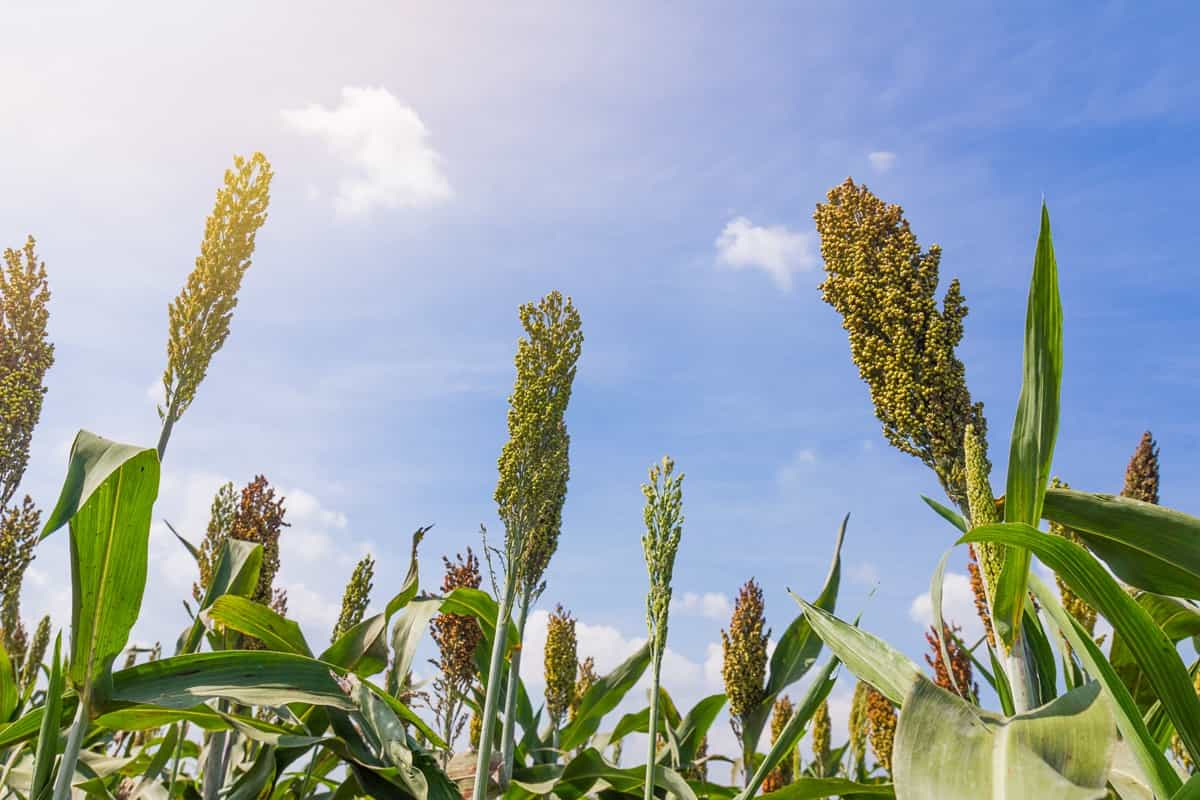
Management
- Predator Use: Utilizing predator reduviid bugs of the Reduviolus species.
- Insecticide Application: Applying carbaryl dust at 10% or quinolphos at 1.5% twice at 10-day intervals, synchronized with the crop’s milky stage, effectively controls earhead bugs.
Grain/Earhead Midge Pest Characteristics and Management
Biology
- Egg Laying: Female grain/earhead midges insert eggs singly into developing florets, typically during pollen-shedding. A single female can lay between 32 to 100 eggs.
- Life Cycle: The life cycle of these midges, from egg to adult, spans 14 to 19 days.
Symptoms of Damage
- Feeding Habits: Maggots of the grain/earhead midge feed inside developing grains.
- Pupation: After feeding, the maggots pupate inside the grains.
- Emergence: Adult midges emerge from the tip of the floret, leaving behind a distinctive white pupal case attached to the floret’s tip. This characteristic symptom indicates infestation.
Management
- Late Sowing: Late sowing reduces the incidence of infestation.
- Larval Parasite: Using larval parasites, such as Tetrastichus spp., has proven effective.
- Predators: Predators like Anthocorid bugs, orius, and ants (Tepinoma indicum) can help control midge populations.
- Insecticide Application: A recommended practice is applying carbaryl 10% dust at a rate of 20 to 30 kg per hectare at 50% flowering and grain formation.
- Alternative Insecticides: Malathion 5% or carbaryl 10% quinolphos 5% dust at 12 kg per hectare has also shown effectiveness in managing grain/earhead midges.
Maize Leaf Aphid Pest and Management in Sorghum
Biology
- Reproductive Strategy: Female maize leaf aphids reproduce without mating, giving birth to live young. A generation of aphids can be completed in approximately a week.
- Year-round Activity: These insects remain active throughout the winter.
Symptoms of Damage
- Feeding Signs: Aphid colonies are typically found feeding on the leaf whorl, leading to the yellowing of leaves.
- Stage Sensitivity: Their densities often decrease as plants progress into the boot and heading stage.
- Sooty Mould: The secretion of honeydew by aphids can lead to growth of sooty mold, which further affects plant health.
Management
- Natural Enemies: Employing natural predators like ladybird beetles, chrysopids, hoverfly larvae, and parasitic wasps can help control aphid populations.
- Chemical Control: Using pesticides such as dimethoate at 0.03% or neem seed kernel extract at 0.04% with soap as a surfactant can effectively manage maize leaf aphids.
In case you missed it: Sorghum Farming in Kenya: A Step-by-Step Production Guide
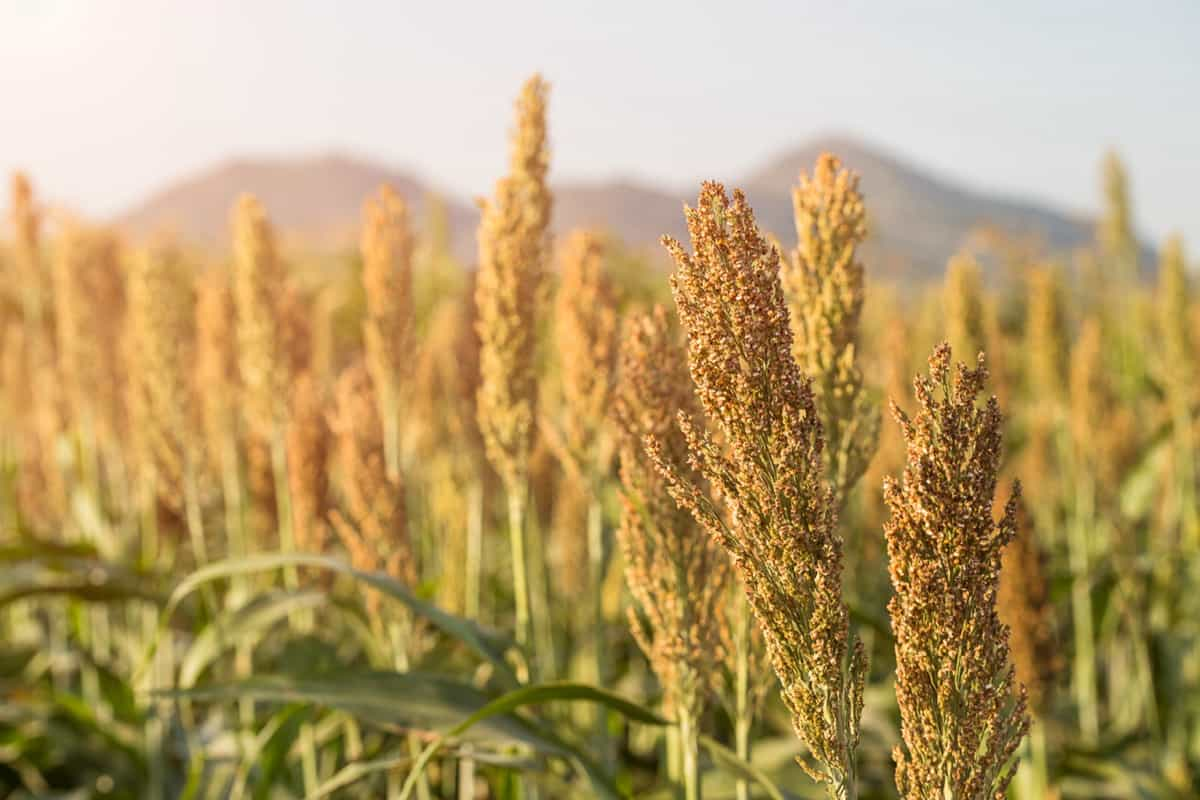
Web Worms Pest and Management in Sorghum
Biology
- Larval Characteristics: Webworms are characterized by narrow, light brown larvae with dark heads and dark lateral lines on their bodies.
- Initial Habitat: Larvae typically remain near the axis of the inflorescence initially.
Symptoms of Damage
- Feeding Behavior: Larvae engage in leaf scraping and later transition to feeding on milky and hard grains.
- Webbing Behavior: These larvae have a unique habit of webbing together adjacent grains using silken threads.
- The extent of Damage: Severe infestations can lead to the entire ear head being completely webbed, with a buildup of excreta and silken threads.
Management
- Physical Removal: Removing webbed ear heads to eliminate the larvae and prevent further damage.
- Chemical Control: Using pesticides such as carbaryl at 10% or malathion at 5% dust at a rate of 20-25 kg per hectare to control webworm populations.
White Grub Pest and Impact in Sorghum
Biology
- Egg Stage: A female white grub lays an average of 27 pear-like white eggs in the soil, enclosed in earthen cells.
- Grub Stage: The grub is fleshy, ‘C’-shaped, and whitish-yellow, typically found near the base of plants.
- Pupa Stage: Pupae are tan to brown and are situated deeper in the soil, within earthen chambers.
- Adult Stage: Adult beetles emerge rusty-red but gradually turn nearly black.
Symptoms of Damage
- Foliage Effects: Damage manifests as yellowing and wilting of leaves.
- Crown Impact: Entire crowns of plants can dry up due to infestation.
- Stem Weakness: Affected stems become easily detachable when pulled.
- Root and Base Damage: White grubs cause extensive harm to roots and the base of the shoot.
Natural Enemies of White Grub
- Parasitoids: Typhia, a parasitic wasp, preys on white grubs.
- Predators: Ground beetles and red ants are among the natural predators that help control white grub populations.
IPM for Sorghum for Insect Pest
Pre-sowing Stage
- Cultural Practices: Deep summer plowing, resistant/tolerant varieties, crop rotation with non-host crops, and sowing ecological engineering plants.
- Mechanical Practices: Uprooting and burning infected plant parts to prevent disease spread.
- Nutrient Management: Application of FYM (Farm Yard Manure) at 5 tons/acre.
- Weed Control: Removal of existing weeds at sowing time.
Sowing Stage
- Cultural Practices: Using healthy, certified, weed-free seeds, proper spacing, and crop rotation with pulses or oilseed crops.
- Mechanical Practices: After harvest, plowing to remove and destroy stubbles, and collection and destruction of white grubs.
- Nutrient Management: Application of NPK fertilizers as per soil test recommendations.
- Weed Control: Application of 2,4-D herbicide or hand weeding as needed.
In case you missed it: Best Fertilizer for Sorghum/Jowar: Organic, NPK, Bio-fertilizers, Requirements, When and How to Apply
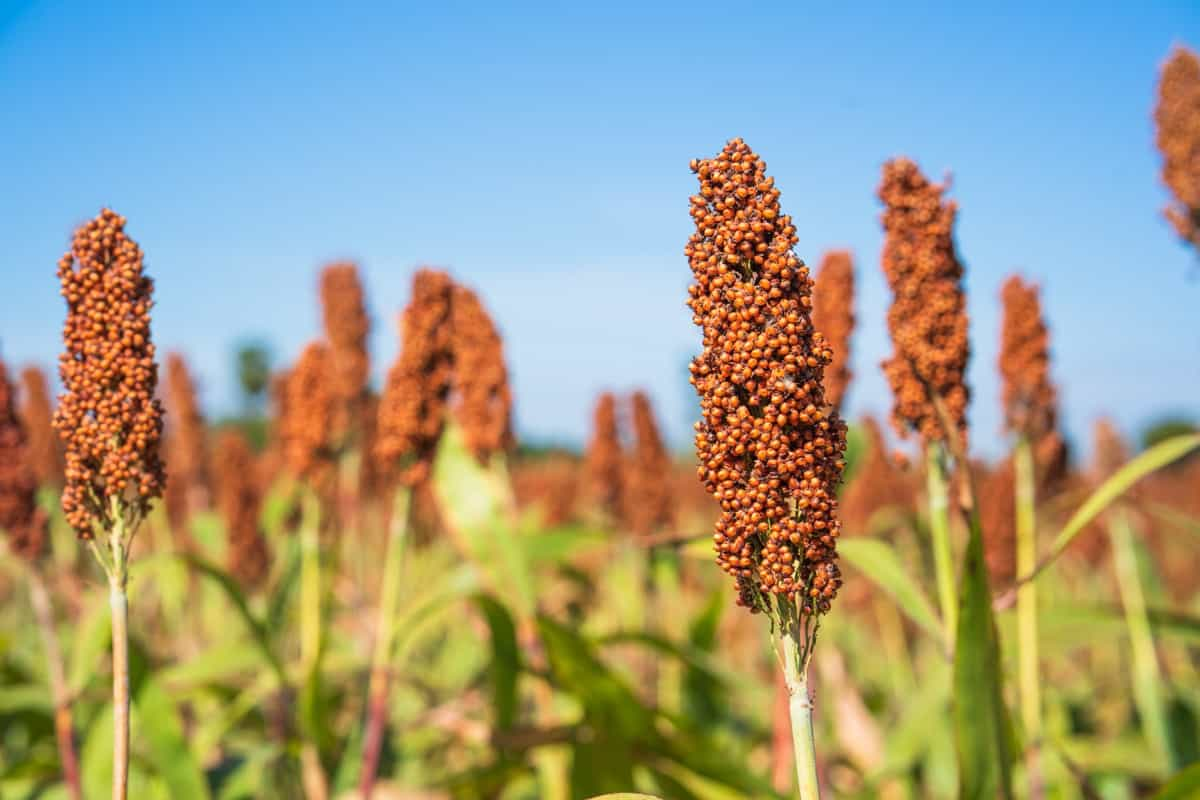
Vegetative Stage
- Cultural Practices: Collect and destroy crop debris, disease-infected and insect-damaged plant parts, provide irrigation at critical stages, avoid waterlogging, and use judicious fertilizers.
- Mechanical Practices: Collection and destruction of eggs, early-stage larvae, and gregarious caterpillars.
- Biological Practices: Conservation of natural enemies through ecological engineering and augmentative release of natural enemies.
Flowering Stage
- Cultural Practices: Removal of Johnson grassy weed.
- Biological Practices: Use neem seed kernel extract and parasitoids (Aprostocetus sp.).
- Chemical Control: Use of appropriate pesticides such as quinalphos and malathion.
Post-harvest Stage
- Cultural Practices: Proper disposal of crop residues and elimination of other susceptible plants.
- Chemical Control: Seed treatment with thiram for certain diseases.
Modern Strategies for Pest Management in Sorghum
Sorghum, a crucial global crop, faces challenges from around 150 insect species, which can reduce productivity by up to 50%. Integrated Pest Management provides a comprehensive overview of these pests, including their common names, species, damage descriptions, distribution, and pest status. The paper also offers insights into host-plant resistance, selective insecticides, and natural enemies.
Modern pest management strategies include cultural and biological controls, botanical and synthetic insecticides, and host-plant resistance. The emphasis is on integrated pest management (IPM), which combines multiple approaches for effective control. Key strategies include selecting resistant plant varieties, crop rotation, field sanitation, optimal planting dates, trap cropping, cultivating non-host crops, and judicious insecticide use to protect pollinators and natural enemies.
The review article serves as a valuable resource for researchers in sorghum entomology and highlights the challenges and prospects in managing sorghum insect pests with various cultivation systems. Emerging strategies, such as semiochemical-based trapping and regulatory policies, offer promising avenues for future sorghum pest management.
In case you missed it: Weed Management in Wheat Farming: How to Control with Organic, Chemical and Cultural Practices
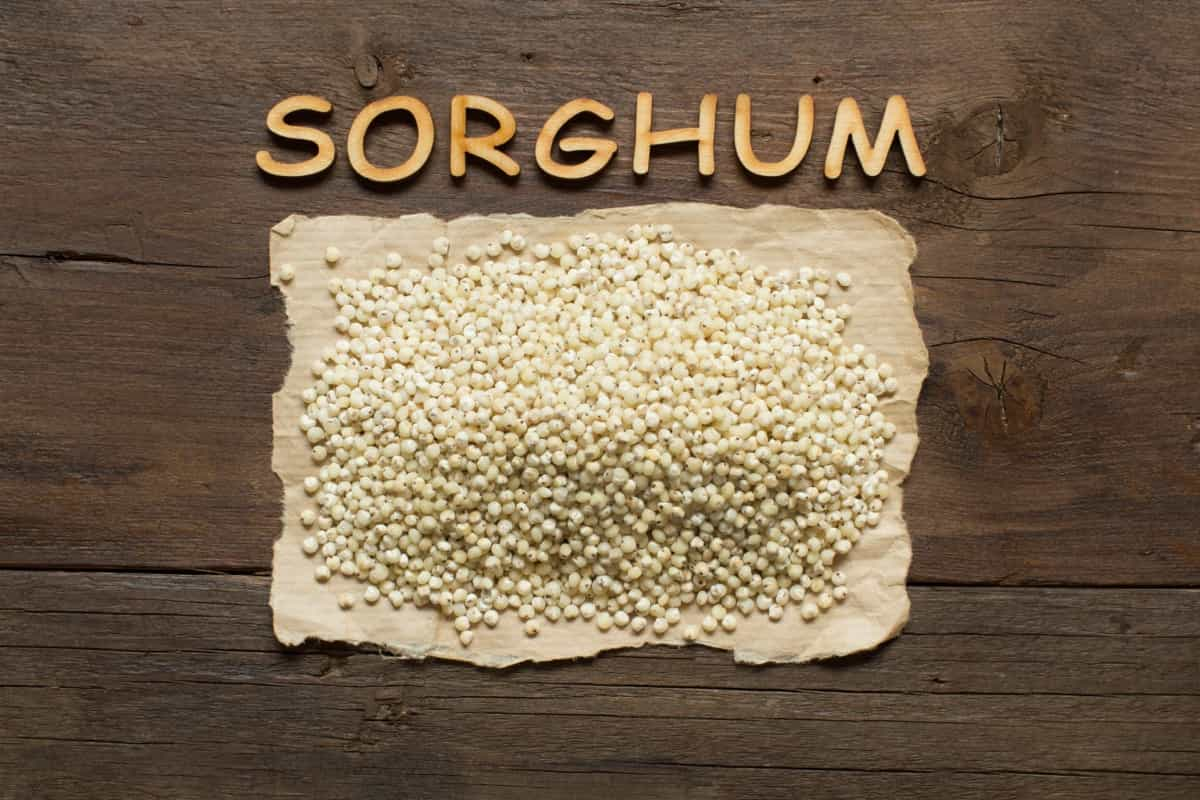
Conclusion
Effective pest management in sorghum involves a multi-faceted approach, including host-plant resistance, crop rotation, biological controls, judicious insecticide use, and cultural practices. By integrating these methods, we can mitigate the impact of major insect pests and safeguard sorghum production and its diverse uses.
- Types of Pesticides Used in Agriculture: A Beginner’s Guide
- Economical Aquaculture: A Guide to Low-Budget Fish Farming
- 15 Common Planting Errors That Can Doom Your Fruit Trees
- How to Make Houseplants Bushy: Effective Tips and Ideas
- Innovative Strategies for Boosting Coconut Pollination and Yield
- Pollination Strategies for Maximum Pumpkin Yield
- The Complete Guide to Chicken Fattening: Strategies for Maximum Growth
- Natural Solutions for Tulip Problems: 100% Effective Remedies for Leaf and Bulb-Related Issues
- Revolutionizing Citrus Preservation: Towards a Healthier, Greener Future
- Natural Solutions for Peony Leaf and Flower Problems: 100% Effective Remedies
- Maximizing Profits with Avocado Contract Farming in India: A Comprehensive Guide
- Natural Solutions for Hydrangea Problems: 100% Effective Remedies for Leaf and Flowers
- The Ultimate Guide to Choosing the Perfect Foliage Friend: Bringing Life Indoors
- From Sunlight to Sustainability: 15 Ways to Use Solar Technology in Agriculture
- The Ultimate Guide to Dong Tao Chicken: Exploring from History to Raising
- The Eco-Friendly Makeover: How to Convert Your Unused Swimming Pool into a Fish Pond
- Mastering the Art of Delaware Chicken Farming: Essentials for Healthy Backyard Flocks
- 20 Best Homemade Fertilizers for Money Plant: DIY Recipes and Application Methods
- How to Craft a Comprehensive Free-Range Chicken Farming Business Plan
- Brighten Your Flock: Raising Easter Egger Chickens for Beauty and Bounty
- How to Optimize Your Poultry Egg Farm Business Plan with These Strategies
- Subsidy for Spirulina Cultivation: How Indian Government Schemes Encouraging Spirulina Farmers
- Ultimate Guide to Raising Dominique Chickens: Breeding, Feeding, Egg-Production, and Care
- Mastering the Art of Raising Jersey Giant Chickens: Care, Feeding, and More
- Ultimate Guide to Raising Legbar Chickens: Breeding, Farming Practices, Diet, Egg-Production
- How to Raise Welsummer Chickens: A Comprehensive Guide for Beginners
- How to Protect Indoor Plants in Winter: A Comprehensive Guide
- Ultimate Guide to Grow Bag Gardening: Tips, Tricks, and Planting Ideas for Urban Gardeners
- Guide to Lotus Cultivation: How to Propagate, Plant, Grow, Care, Cost, and Profit
- Agriculture Drone Subsidy Scheme: Government Kisan Subsidy, License, and How to Apply Online
- Ultimate Guide to Raising Araucana Chickens: Breed Profile, Farming Economics, Diet, and Care
- Bringing Hydroponics to Classroom: Importance, Benefits of Learning for School Students
- Ultimate Guide to Raising Polish Chickens: Breed Profile, Farming Economics, Diet, and Care
- Ultimate Guide to Raising Australorp Chickens: Profile, Farming Economics, Egg Production, Diet, and Care
- Silkie Chicken Farming: Raising Practices, Varieties, Egg Production, Diet, and Care
- Sussex Chicken Farming: Raising Practices, Varieties, Egg Production, Diet and Care